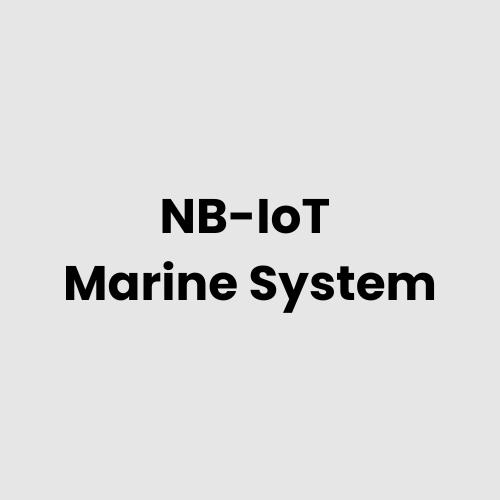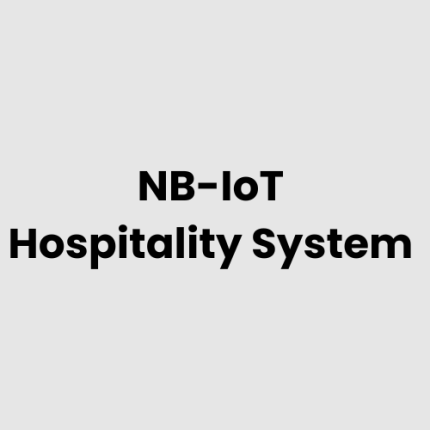Description
GAO Tek Inc.’s NB-IoT Enabled Marine IoT System transforms maritime operations with robust connectivity and real-time monitoring capabilities.
- Vessel Connectivity: NB-IoT modules onboard vessels ensure seamless communication with shore-based systems.
- Environmental Monitoring: Collects real-time data on weather, sea conditions, and environmental factors.
- Fleet Management: Centralized tracking of vessel location, fuel consumption, and maintenance needs.
- Cargo Monitoring: Tracks temperature, humidity, and movement of sensitive goods in real-time.
- Safety Systems: Integrates sensors for collision avoidance, emergency alerts, and crew monitoring.
- Energy Optimization: Monitors energy usage to improve fuel efficiency and reduce emissions.
- Port and Harbor Integration: Interfaces with smart port systems for efficient docking and logistics.
List of Hardware of the NB-IoT Enabled Marine IoT System
- NB-IoT Gateways: Ensure stable communication between vessels and shore stations.
- Marine Sensors: Includes GPS, depth sensors, temperature gauges, and water quality monitors.
- Asset Tags: RFID or BLE-enabled tags for tracking containers and cargo.
- Onboard Cameras: High-resolution cameras for surveillance and inspection.
- Weather Stations: Collect data on wind speed, humidity, and atmospheric pressure.
- Collision Avoidance Sensors: Ultrasonic or radar-based systems for obstacle detection.
- Energy Meters: Monitor fuel consumption and onboard power usage.
- Crew Wearables: Smart devices to track crew health and location.
- Smart Buoys: Deployed at strategic locations for navigation and environmental monitoring.
Physical Placement Considerations
- NB-IoT Gateways: Installed in vessel control rooms or bridge areas for strong connectivity.
- Marine Sensors: Placed strategically on vessel exteriors, cargo holds, and engine rooms.
- Asset Tags: Attached to containers, pallets, and high-value cargo.
- Onboard Cameras: Mounted on decks, engine rooms, and cargo areas for comprehensive coverage.
- Weather Stations: Positioned on vessel masts for accurate atmospheric data.
- Collision Avoidance Sensors: Located on the bow and sides of the vessel for obstacle detection.
- Energy Meters: Integrated with fuel lines and electrical systems for precise monitoring.
- Crew Wearables: Distributed to personnel for health and safety tracking.
- Smart Buoys: Deployed near harbors or shipping lanes for critical data collection.
Hardware Architecture
- Sensor Network: Includes GPS, environmental, and operational sensors across the vessel.
- Communication Modules: NB-IoT devices for low-power, wide-area data transmission.
- Edge Computing Nodes: Perform data preprocessing to reduce latency and bandwidth usage.
- Central Processing Unit: Onboard systems aggregate and process sensor data for real-time decision-making.
- Shore Station Integration: Connects vessel systems with onshore monitoring and control centers.
- User Interfaces: Dashboards and mobile apps for operators to view and manage system data.
Deployment Considerations
- Marine-Grade Hardware: Devices must withstand harsh maritime environments, including saltwater corrosion and extreme temperatures.
- Scalability: Supports integration across large fleets and additional sensors or features.
- Interoperability: Ensures compatibility with existing marine systems and international shipping protocols.
- Energy Efficiency: Optimizes power usage to align with fuel and sustainability goals.
- Security: Implements robust encryption to protect sensitive data and prevent unauthorized access.
- Regulatory Compliance: Meets maritime safety and environmental standards.
List of Relevant Industry Standards and Regulations
- MARPOL – International Convention for the Prevention of Pollution from Ships
- SOLAS – Safety of Life at Sea
- IEC 60945 – Maritime navigation and radio communication equipment
- ISO 8217 – Fuel standards for marine engines
- IMO Guidelines – Maritime cybersecurity
- ITU-R M.1371 – AIS communication standards
Local Server Version
GAO Tek offers a local server version of the NB-IoT Enabled Marine IoT System tailored for maritime applications:
- Offline Functionality: Enables critical operations without dependency on external networks.
- Enhanced Data Privacy: Keeps sensitive operational and cargo data within vessel or company boundaries.
- Real-Time Response: Local processing ensures minimal latency for navigation and safety decisions.
- Custom Solutions: Configurable to meet the specific requirements of individual vessels or fleets.
Cloud Integration and Data Management
- Global Connectivity: Seamless integration with cloud platforms for fleet-wide monitoring.
- Data Analytics: Processes operational and environmental data to optimize performance.
- Predictive Maintenance: AI-driven insights help preempt equipment failures.
- Multi-Vessel Management: Centralized control and reporting for large fleets.
- Regulatory Reporting: Automates documentation and compliance tracking.
- Secure Data Sharing: Allows controlled access for stakeholders, including port authorities and logistics partners.
GAO Case Studies of NB-IoT Enabled Marine IoT System
USA Case Studies
- Miami, Florida
In Miami, NB-IoT is used to monitor fuel efficiency in yachts and fishing boats, reducing operational costs and environmental impact. GAO Tek offers innovative solutions for real-time tracking and analysis in marine applications. Learn about marine fuel efficiency. - Seattle, Washington
NB-IoT systems in Seattle support real-time navigation and weather updates for fishing vessels, ensuring safer operations. GAO Tek’s advanced marine IoT platforms provide seamless data integration to enhance maritime safety. Explore IoT and maritime safety. - San Diego, California
In San Diego, harbor authorities use NB-IoT to monitor water quality, ensuring compliance with environmental standards. GAO Tek’s IoT solutions enable continuous environmental monitoring for sustainable marine practices. Learn more about marine environmental monitoring. - New Orleans, Louisiana
NB-IoT systems in New Orleans track cargo conditions on shipping vessels, ensuring optimal storage for perishable goods. GAO Tek helps streamline marine logistics with robust IoT solutions. Discover smart cargo management. - Houston, Texas
Houston utilizes NB-IoT for predictive maintenance of port equipment, minimizing downtime and improving efficiency. GAO Tek supports these initiatives with IoT-enabled maintenance solutions. Read more about smart port innovations. - Boston, Massachusetts
NB-IoT enables Boston’s coastal patrol to monitor vessel movements, ensuring maritime security and compliance with local regulations. GAO Tek provides the necessary tools for real-time tracking and analytics. Explore coastal security solutions. - Tampa, Florida
In Tampa, NB-IoT assists in managing marina berths by tracking vessel occupancy and facilitating efficient scheduling. GAO Tek’s IoT platforms help optimize resource use in marinas. Learn about smart marina management. - Baltimore, Maryland
Baltimore leverages NB-IoT to monitor underwater infrastructure, ensuring the stability of piers and docks. GAO Tek provides durable IoT systems designed for challenging marine environments. Discover underwater IoT applications. - Portland, Maine
NB-IoT sensors in Portland track lobster traps’ locations, reducing gear loss and supporting sustainable fishing. GAO Tek delivers IoT technologies that enable efficient and eco-friendly fisheries management. Read about IoT in sustainable fishing. - Savannah, Georgia
In Savannah, NB-IoT monitors tidal conditions to optimize shipping schedules and ensure safe navigation. GAO Tek’s IoT platforms provide accurate, real-time data for maritime operations. Explore tidal data management. - Charleston, South Carolina
NB-IoT systems in Charleston are used to monitor marine wildlife populations, aiding conservation efforts. GAO Tek supports these projects with high-precision IoT sensors. Learn about marine wildlife monitoring. - Anchorage, Alaska
Anchorage uses NB-IoT for ice navigation systems, helping ships navigate frozen waterways safely. GAO Tek offers reliable IoT solutions tailored for harsh marine conditions. Discover IoT in Arctic navigation. - Norfolk, Virginia
In Norfolk, NB-IoT tracks military vessel movements to enhance operational readiness and security. GAO Tek supports these strategic applications with robust IoT platforms. Explore smart defense systems. - San Francisco, California
San Francisco employs NB-IoT to monitor and manage coastal erosion, protecting infrastructure and natural habitats. GAO Tek provides reliable IoT solutions for environmental management. Learn about coastal resilience. - Galveston, Texas
NB-IoT in Galveston enables smart buoy systems that provide real-time data on wave heights and water temperatures. GAO Tek’s IoT technologies enhance maritime safety and research. Explore smart buoy technology.
Canada Case Studies
- Halifax, Nova Scotia
In Halifax, NB-IoT supports monitoring of fishing fleets, improving catch traceability and compliance with sustainable practices. GAO Tek’s IoT solutions ensure seamless tracking for Canada’s marine industry. Learn about traceable fisheries. - Vancouver, British Columbia
Vancouver uses NB-IoT to optimize ferry operations by monitoring engine performance and passenger flows. GAO Tek’s advanced IoT platforms enhance transportation efficiency in marine applications. Explore smart ferry systems.
Navigation Menu for NB-IoT
Navigation Menu for IoT
- LORAWAN
- Wi-Fi HaLow
- Z-WAVE
- BLE & RFID
- NB-IOT
- CELLULAR IOT
- GPS IOT
- IOT SENSORS
- EDGE COMPUTING
- IOT SYSTEMS
Our products are in stock and can be shipped anywhere in the continental U.S. or Canada from our local warehouse. For any further information, please fill out this form or email us.
We are actively looking for partners who are like us located in the U.S. and Canada. For more information on partnering with GAO, please visit Partner with GAO Tek Inc.It lists various ways to partner with GAO, such as OEM Partnerships, Technology Integration, Distribution and Reselling Opportunities, Presenting at the Leading Event Tek Summit, Joint R&D Projects, Training and Consulting Services, Industry-Specific Collaborations, Research and Academic Partnerships.



